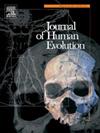Functional and behavioral variation in intrinsic hand and foot digit proportions in primates
IF 3.1
1区 地球科学
Q1 ANTHROPOLOGY
引用次数: 0
Abstract
The relative elongation of the digits on the autopods has long been considered as an adaptation for an arboreal lifestyle shared by several tetrapods. In primates, this morphological adaptation constitutes one of the defining characters of the order and is correlated to their enhanced manual and pedal grasping capabilities. However, primates are highly diversified in terms of body mass and locomotor repertoire, and it remains unclear to what extent the elongation of proximal and intermediate phalanges relative to metapodials (i.e., the phalangeal index) correlates with body mass or grasping performances during arboreal locomotion. In this study, we tested the effect of body mass, grasping performance, and phylogeny on the manual and pedal phalangeal indexes in 58 species of nonhuman primates, including strepsirrhines, platyrrhines, and catarrhines. We computed a grasping score as a proxy for grasping performance based on the known locomotor repertoire of each species. We found that body mass negatively correlates with the intrinsic digit proportions of the hand, whereas the grasping score positively correlates with the intrinsic digit proportions of both the hand and foot. Our results highlight the different functional roles of the hand and foot in nonhuman primates. The hand is more influenced by changes in body size (allometric constraints), while the foot primarily functions to anchor to arboreal supports. Moreover, finger elongation appears most critical for enhancing grasping performance in species weighing over 5 kg as the general decrease in power-to-weight ratio and the specific postural adaptations in larger species likely increase locomotor constraints on the forelimb. By building a finer model of the morphofunctional complexes of the hand and foot in primates, linking phalangeal index, body mass, and locomotor repertoire, this comparative study will also help to better understand the evolution of autopodial adaptations in other arboreal models such as in rodents and marsupials.
灵长类动物内在手和足趾比例的功能和行为变化
自动足类动物趾趾的相对伸长一直被认为是对几种四足动物共同的树栖生活方式的一种适应。在灵长类动物中,这种形态适应构成了该目的定义特征之一,并与它们增强的手动和脚踏抓取能力有关。然而,灵长类动物在体重和运动能力方面高度多样化,目前尚不清楚近端和中间指骨相对于跖骨的伸长(即指骨指数)在多大程度上与树木运动时的体重或抓取性能相关。在这项研究中,我们测试了58种非人灵长类动物的体重、抓握能力和系统发育对手指骨和脚指骨指数的影响,包括链鼻猴、白颈鼻猴和卡他鼻猴。我们计算了一个抓取分数作为抓取性能的代理基于已知的运动技能的每个物种。我们发现,身体质量与手的内在数字比例负相关,而抓握得分与手和脚的内在数字比例正相关。我们的研究结果强调了手和脚在非人类灵长类动物中的不同功能角色。手更多地受到身体大小变化(异速生长限制)的影响,而脚的主要功能是锚定在树木的支撑上。此外,在体重超过5公斤的物种中,手指伸长似乎是提高抓握性能的最关键因素,因为大型物种中力量重量比的普遍下降和特定的姿势适应可能会增加前肢的运动限制。通过建立一个更精细的灵长类手足形态功能复合物模型,将指骨指数、体重和运动能力联系起来,这项比较研究也将有助于更好地理解其他树栖动物模型(如啮齿动物和有袋动物)的自足适应进化。
本文章由计算机程序翻译,如有差异,请以英文原文为准。
求助全文
约1分钟内获得全文
求助全文
来源期刊

Journal of Human Evolution
生物-进化生物学
CiteScore
6.30
自引率
15.60%
发文量
104
审稿时长
3 months
期刊介绍:
The Journal of Human Evolution concentrates on publishing the highest quality papers covering all aspects of human evolution. The central focus is aimed jointly at paleoanthropological work, covering human and primate fossils, and at comparative studies of living species, including both morphological and molecular evidence. These include descriptions of new discoveries, interpretative analyses of new and previously described material, and assessments of the phylogeny and paleobiology of primate species. Submissions should address issues and questions of broad interest in paleoanthropology.
 求助内容:
求助内容: 应助结果提醒方式:
应助结果提醒方式:


